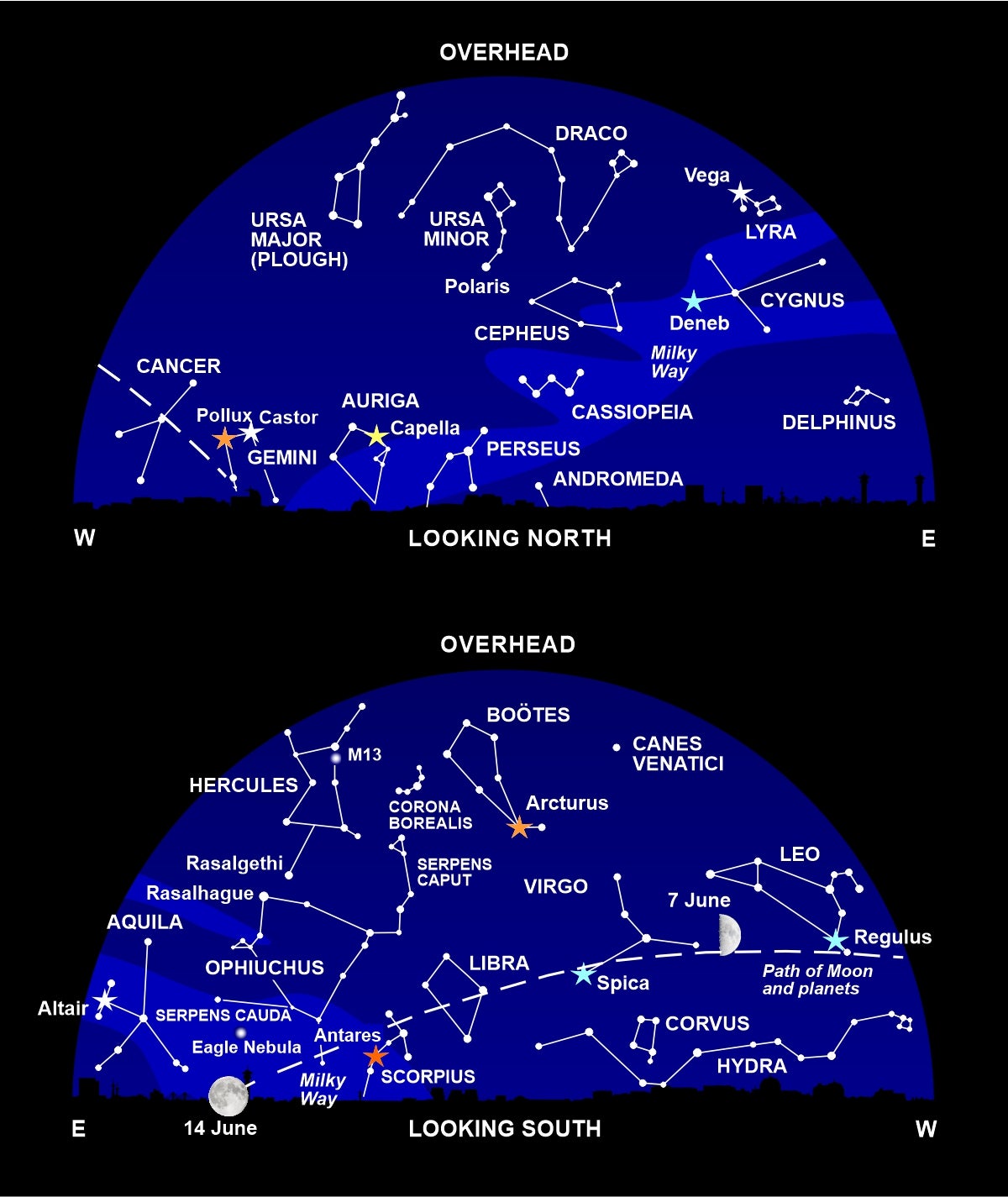
Rising in the east this month, two mighty giants challenge each other head-to-head in the night sky. That’s the exciting news: on the flip side, they are both composed of stars so faint you could easily overlook these great heroes.
Conveniently, we can use some bright stars to guide us. Bright red Antares lies low in the south and the large irregular egg-shape of stars to its upper left marks the outline of Ophiuchus (the Serpent-Bearer). To the Romans, he represented Aesculapius, the god of healing. According to legend, he was held captive in a snake-infested prison when he saw a serpent bring a herb to a mortally wounded snake – which then instantly recovered. Aesculapius then harvested this herb and set about curing sick humans. (That’s also why the traditional medical symbol features two snakes wrapped around a staff.)
The ancient healer is still carrying his snake in the sky, as the star pattern Serpens (the Serpent). It’s unique among the constellations in that it comes in two unconnected parts, to either side of Ophiuchus himself. Serpens Caput is the snake’s head; while Serpens Cauda represents its tail.
The most interesting astronomical object in these snake-wrangling constellations lies below the serpent’s tail. Through a small telescope, the Eagle Nebula is a giant cloud of glowing gas, speckled with newborn stars, and shaped like a soaring bird of prey. Hidden deep inside are dark towering silhouettes of dust and gas, the nursery of a new generation of stars. They achieved fame as the Pillars of Creation, after they appeared in a stunning image from the Hubble Space Telescope.
Above Ophiuchus, between the brilliant stars Vega and Arcturus, you can make out the shape of mighty Hercules, delineated by six faintish stars. Look in the upper part of the constellations with binoculars to spot a fuzzy patch; a telescope reveals it’s a swarm of stars in a tight ball. This star cluster, known by its catalogue number as M13, contains almost a million stars and lies 22,000 lightyears away from us.
Although this constellation apparently commemorates a famous superhero, it wasn’t always so. The present name was the work of a Hercules-obsessed Greek poet called Panyassis. Going back to deeper antiquity, this star pattern was known simply as the Kneeler. Bizarrely, traditional star maps show him hanging upside down in the sky, kneeling on Draco, a dragon that lies above Hercules and writhes around the north pole of the sky. Hercules’s head is represented by the star Rasalgethi, at the bottom of the constellation pattern. It’s a tete-a-tete with Rasalhague, the head of the (right-way up) giant, Ophiuchus.
We could put this odd arrangement of sky figures down to whimsy on the part of the ancient constellation makers. But there is a logical explanation – if we’re prepared to push the origin of the constellations way back in time, well before the period in Mesopotamia around 3,000 years ago when many familiar patterns like the constellations of the Zodiac were first named.
The key to this interpretation is that the constellations aren’t fixed in place in the sky, because the Earth’s axis is slowly wobbling around in space – a motion known as the precession of the equinoxes. If we could view the sky as it was 5,000 years ago, we’d see Ophiuchus much higher in the sky, with his head right at the overhead point. Looking in the opposite direction, Hercules would be the right way up, with Draco below him, and Hercules’s head also at the zenith – the two giants facing each other eye-to-eye.
For me, it’s a convincing argument. And as I see Hercules and Ophiuchus rising, it’s humbling to think that – for all their lack of ostentation – I’m viewing two of the most ancient of our constellation patterns.
What’s Up
The distinctive catlike shape of Leo (the Lion) hangs in the western sky, with Virgo (the Virgin) to the left and bright Arcturus above. To the left lie the sprawling constellations of Hercules and Ophiuchus. Rising in the northeast you’ll find the brilliant star Vega and the cross-shape of the constellation Cygnus (the Swan).
The Full Moon on 14 June is close enough to the Earth to count as a “supermoon”, though it’s not quite as big and bright as the supermoon in July.

This month, we don’t get to see any planets until after midnight, when a procession of our neighbour worlds begins to rise in the east. First on the scene is Saturn, appearing above the horizon around 12.30am, followed by much brighter Jupiter an hour later. Next up is Mars, around 2am. Glorious Venus rises an hour after that, moving under the Pleiades (the Seven Sisters star cluster) on the morning of 23 June and lying close to the crescent Moon before dawn on 26 and 27 June.
During the last week of the month, you have an opportunity to complete the roster of planets visible to the unaided eye, when Mercury appears to the lower left of Venus in the dawn twilight.
Diary
2 June: Moon near Castor and Pollux
3 June: Moon near Castor and Pollux
5 June: Moon near Regulus
7 June, 3.48 pm: First Quarter Moon
9 June: Moon near Spica
10 June: Moon near Spica
13 June: Moon near Antares
14 June, 12.52 pm: Full Moon, supermoon
16 June: Mercury at greatest elongation west
21 June, 4.11 am: Last Quarter Moon near Jupiter
21 June, 10.13 am: Summer Solstice
29 June, before dawn: Jupiter very near Mars
29 June, 3.52 am: New Moon
Philip’s 2022 Stargazing (Philip’s £6.99) by Nigel Henbest reveals everything that’s going on in the sky this year.







